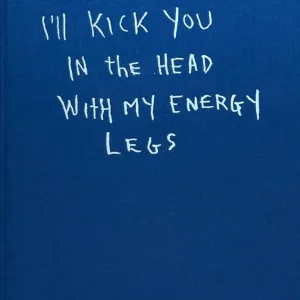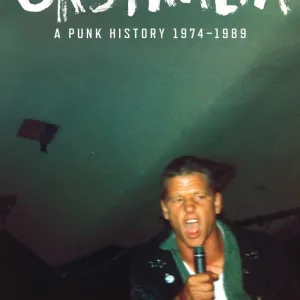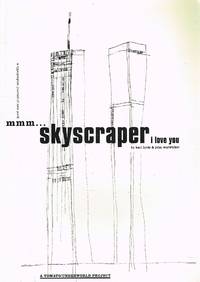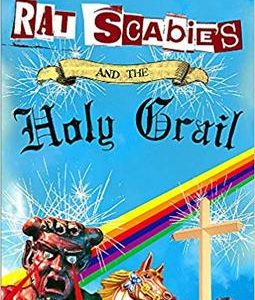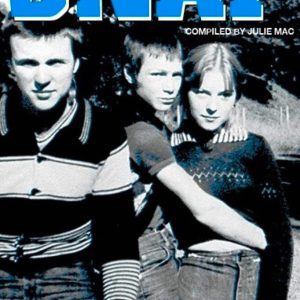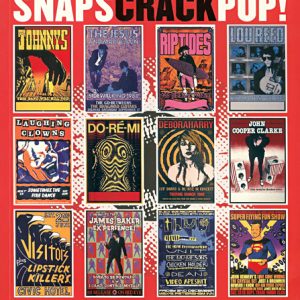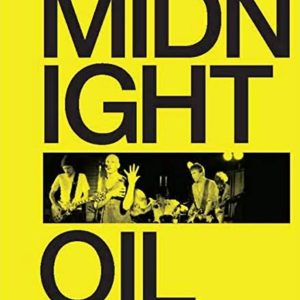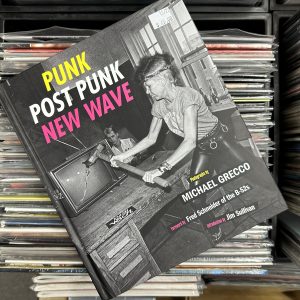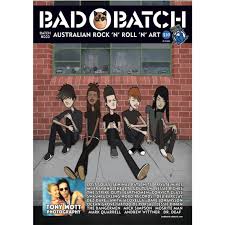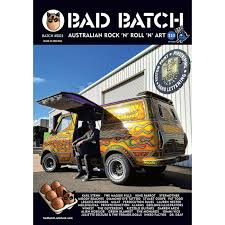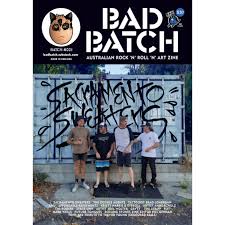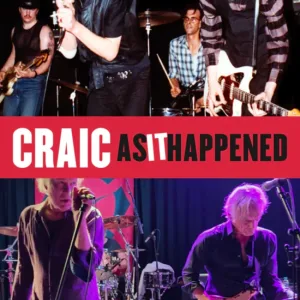Sign in
Login
Register
I’ll Kick You In The Head With My Energy Legs; Johnnie Craig
$75.00
I'll Kick You In The Head With My Energy Legs depicts the coming of age, travels and traits of a group of skateboarders from London, who managed to escape the grips of a nine-to-five. Each character offers a different dynamic to the ongoing story; be it walking along the sludge covered beaches of the river Thames in search of an American visiting friend who happened to be taking an emergency shit' after accidentally drinking an entire bottle of laxative, or a journey to the hospital to fix a dislocated elbow, or playing with a dead pigeon.
Read more
SPECIALIST FABRICATOR: Gary Mundy (Amphetamine Sulphate) Paperback Book
$25.00
Gary Mundy is the founding member of Ramleh, and ran the legendary label Broken Flag. In this frank memoir, Mundy examines themes of alienation, depression, artistic practice and what it means to be alive.
Amphetamine Sulphate - Paperback Book (New)
Read more
Radio Birdman; When the Birdmen Flew, An Illustrated History by George Matzkov
$125.00
Radio Birdman - When the Birdmen Flew: An Illustrated History Hardcover Book
When The Birdmen Flew is an Illustrated History book, jam packed full of photos, memorabilia and ephemera from 1974 to 2007 to create the ultimate Radio Birdman rock and roll book.
The bands archives and scrapbooks have been collected by lifelong Radio Birdman fan George Munoz with additional items supplied by other Birdman fans from around the world.
George has been collecting Radio Birdman files since 1976 and has compiled a large collection which he dreamed of putting together into a book. That time has now come and High Voltage Publishing is proud to make that dream come true.
The books starts from early days and the beginnings of Radio Birdman. Rare early photos, flyers, posters, set lists and everything in between and much of it unseen for years or never seen at all. The best items have been chosen and presented in this huge book.
Beautifully designed and laid out by George Matzkov.
Read more
Orstralia; A punk history 1974-1989 by Tristan Clark
$40.00
With appeal to more than just punk history obsessives, Orstralia offers an unprecedented snapshot of an underacknowledged segment of Australian life and history.
Far from punk’s more modish North Atlantic core in the late 1970s, discontented youth in Australia were enacting similar musical and cultural reckonings. Yet in spite of Australia's purported “laid-back” national demeanour, punks there were routinely met with insult, fist, or the police baton.
More subterranean than the national scandal that was punk back in “homeland” Britain, Australia’s own bands nonetheless came to be heralded internationally. Orstralia represents the first definitive account of the country’s initial years, from progenitors the Saints and Radio Birdman in the mid-70s, through the emergence of hardcore in the 1980s, to the stylistic diffusion that accompanied transition to the 1990s.
Based on over 130 interviews, Orstralia documents the most renowned to the most fleeting and obscure acts the nation produced. Included are equally engrossing and shocking personal narratives befitting such a passionate and intemperate cultural form, as well as punk’s placement within broader Australian society at the time.
“Australia has some claim to being a punk founder nation, most obviously through the influence of the Saints and Radio Birdman. In Orstralia, Tristan Clark explores the wider terrain to recover a vibrant prepunk, punk, and postpunk history that captures the vibrancy and excitement of a culture brimming with ingenuity and teenage verve. A brilliant book and essential reading for all those interested in punk's cultural past.”
—Matthew Worley, author of No Future: Punk Politics and British Youth Culture, 1976–84
“If your knowledge of Australian punk grinds to a halt at the Saints, Radio Birdman, the Hard-Ons, and Vicious Circle, Orstralia is a deep dive into that country’s turbulent alternative underground of the late 1970s and ’80s, when rebellious youths clashed with the police (not to mention the church, the government, the media . . . authority in general), rival subcultures, their parents and even themselves. Proving that an oppressive police state is no match for subversive creativity in the long run, Australian punk evolved and thrived in the face of such adversity—very much its own beast given its isolation from London and New York—and this forensically researched tome is its story, written in such detail and with such fascinating insight, you can relive it all vicariously without having your nose broken and discover a treasure trove of passionate noise into the bargain. This is an important and entertaining piece of work.”
—Ian Glasper, author of Burning Britain: The History of UK Punk 1980–1984 and The Day the Country Died: A History of Anarcho Punk 1980 to 1984
Read more
Mmm…Skyscraper I Love You; Karl Hyde & John Warwicker
$75.00
Originated by Tomato, this work is closely related to the message and imagery of techno band Underworld's music, creating a typographic map of a journey through the streets of New York.
This book is secondhand and is in great condition
Read more
Rat Scabies and the Holy Grail; Christopher Dawes
$65.00
Rat Scabies And The Holy Grail is a 2005 book written by Christopher Dawes, published by Sceptre Books in the UK and Thunder's Mouth Press in the US. It is a gonzo-esque quest to find the Holy Grail by punk rock legend Rat Scabies, the one-time drummer of The Damned, with whom Dawes strikes up a friendship when the two become neighbours in the London suburb of Brentford.[1][2][3][4]
"The book, which has been described as "The Da Vinci Code gets the punk rock treatment" (The Bookseller), begins with Scabies introducing Dawes to the alleged mystery of Rennes-le-Château, a remote French village associated with all manner of esoteric conspiracy theories. Scabies and Dawes make several trips to Rennes-le-Château and also visit other places said to be linked to the Holy Grail, including Rosslyn Chapel in Scotland. The book is an often hilarious account of the pair’s adventures - they even manage to wangle themselves an invitation to a Knights Templar initiation ceremony - and its supporting cast of characters includes Henry Lincoln (the author of Holy Blood, Holy Grail) and a CIA operative, plus assorted treasure hunters, occultists, alien channelers, reincarnated medieval heretics, and numerous members of secret societies." Wikipedia
Read more
SNAP Sharpies Urban Folklore Australia 1952-1987; Julie Mac
$35.00
SNAP sketches the timeline of a lost Australian sub-culture, the teenage Sharpie gangs. Tough and stylish, the Sharpies created their own diverse family, where mateship and defiance were valued over race, colour or authority. SNAP is loaded with photos, snippets from the internet and first-hand recollections from former Sharpies and observers.
Each generation of Sharpies, the 60s, early 70s, mid 70s, late 70s and the 1980s are fiercely protective of their own style of hair, clothing, footwear, music, dance and mannerisms. Their voices are strong as they argue through the pages as each group believes the sharpies that followed are dickheads and imposters!
Read more
SNAPS CRACK POP! John Foy & Jim Paton
$66.00
Utilising the rock posters of Skull Printworks and graphics of Red Eye and Black Eye Records, the book documents the unusual career path of designer and reluctant record executive, John Foy. It’s traverses his experiences in the original 70’s Punk era, legendary record stores, trading 60’s psychedelic posters, and more. With humour as weapon of choice, Foy establishes facts and dispels myths. Rich in colour throughout, the visuals of ‘Snaps, Crack & Pop’ have been brilliantly realised by former Red Eye art director Jim Paton. It’s a book like no other.
Read more
MIDNIGHT OIL; The Power and the Passion
$35.00
Midnight Oil are one of the most 'Australian' rock bands this country has produced.
Born from the Australian pub rock scene that gave us AC/DC, Cold Chisel and INXS, the Oils were able to break out of that scene without compromising themselves in any way. Indeed, their breakthrough overseas record was the most Australian album they made.
But it wasn't just the subject matter that made them fiercely Australian; it was their stubborn independence, and their refusal to play the rock'n'roll game and respect its rules and masters. But more than any of this is the adrenaline rush of an Oils show. Performances so intense that witnesses swore they had seen the greatest Oils gig ever! Such was the belief that something so powerful could surely not take place regularly.
When they took this overseas, audiences could often not understand a word they were saying, but musically they recognised a common language: powerful, unadulterated live performances.
There is no band whose live shows are spoken of with the same awe as the Oils.
Read more
SERGE GAINSBOURG: A Fistful of Gitanes; Paperback Book (Sylvie Simmons) 2001
$35.00
Gainsbourg, French, Jazz, Pop, Playboy; Paperback Book - VG Used condition (Light creasing in covers)
In this, the first English biography to capture Gainsbourg in all his contradiction and gleeful outrageousness, Simmons tells the fascinating story of the Gallic star. Drawing on hours of new interviews with his intimates-among them Jane Birkin, Sly & Robbie, Marianne Faithfull, and celebrated producer Philippe Lerichomme-Simmons describes in crackling prose the scope of Gainsbourg's achievement while doing full justice to his complicated emotional life. Simmons's work will stand as the definitive take on a dizzying genius.
Read more
© Trash Cult 2020. Website by Travis Pithie

